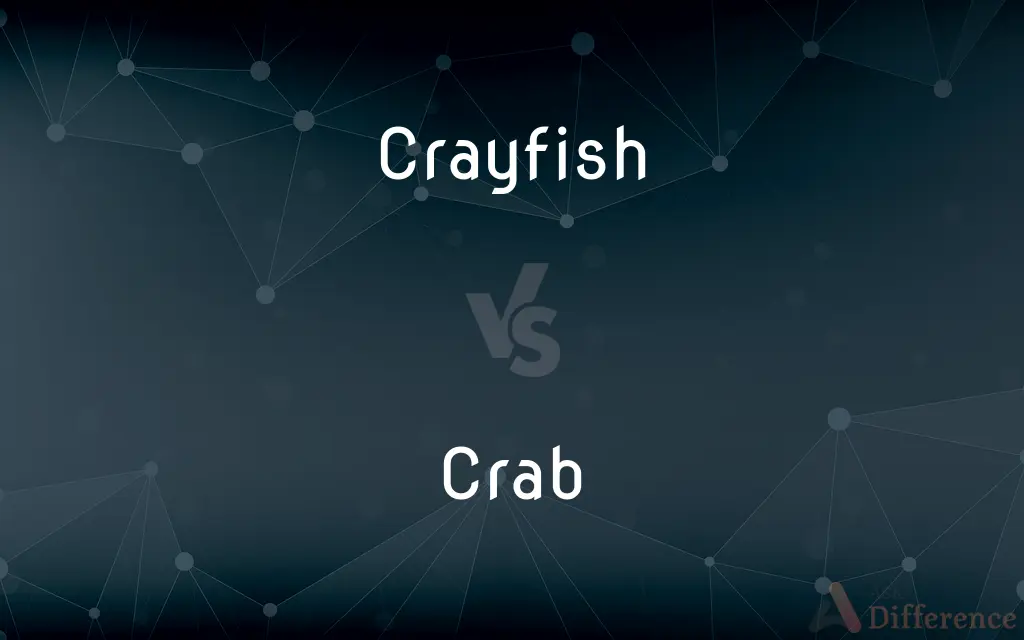Crayfish vs. Crab — What's the Difference?
By Tayyaba Rehman & Maham Liaqat — Updated on March 12, 2024
Crayfish are freshwater crustaceans resembling small lobsters, living in rivers and lakes, while crabs are marine and sometimes freshwater crustaceans, known for their sideways walk and wide, flat bodies.

Difference Between Crayfish and Crab
Table of Contents
ADVERTISEMENT
Key Differences
Crayfish, also known as crawfish or crawdads in some regions, are primarily freshwater organisms found in rivers, lakes, and streams. They have a similar structure to lobsters, with long bodies and large claws used for feeding and defense. Crabs, on the other hand, are more commonly associated with marine environments, though some species inhabit freshwater and terrestrial habitats. Crabs are distinguished by their shorter, wider bodies and the unique sideways walk.
Crayfish have two large claws, called chelae, which are prominent and used for various purposes including defense, communication, and manipulation of their environment. Crabs also possess claws but are more recognized for their wide variety of sizes and shapes, with some species having significantly larger claws relative to their body size. The body shape and size of the claws serve different ecological and biological functions in their respective environments.
The habitat of crayfish is predominantly freshwater ecosystems where they play a crucial role in the food web, acting as both predators and prey. They are adept at hiding under rocks and burrowing into mud to avoid predators. Crabs, however, are found in a wider range of habitats including oceans, estuaries, and even on land. Their adaptation to various environments reflects in their diverse diet and behaviors.
Reproduction in crayfish involves the female carrying fertilized eggs under her tail until they hatch, a common trait among many aquatic invertebrates. Crab reproduction also involves the female carrying eggs, but the method of releasing larvae into the water column is a significant difference, reflecting their adaptation to marine life where larvae disperse widely before settling down.
Crayfish and crabs are both popular in cuisine around the world, though the methods of preparation and the cultural significance of each can vary greatly. Crayfish are often associated with Southern United States cuisine, where large "crawfish boils" are a traditional social event. Crabs, with their diverse species, are a staple seafood in many coastal regions, prepared in a myriad of ways depending on local traditions and available species.
ADVERTISEMENT
Comparison Chart
Habitat
Primarily freshwater, in rivers and lakes
Mostly marine, some species in freshwater and on land
Body Shape
Long bodies resembling small lobsters
Wide, flat bodies adapted for a variety of habitats
Locomotion
Walk forward and backward
Known for their sideways walk
Claws
Two large claws used for feeding and defense
Claws vary in size; some species have one larger claw
Reproduction
Females carry fertilized eggs under their tails
Females carry eggs, releasing larvae into the water
Compare with Definitions
Crayfish
Crayfish can also indicate the health of the freshwater habitats they inhabit.
Scientists study crayfish populations as bioindicators of water quality in rivers.
Crab
Crabs have a diverse diet and adapt to various habitats, from deep sea to shorelines and even land.
Coastal crabs often venture out of the water, feeding on detritus and small organisms.
Crayfish
Crayfish use their large claws for feeding, defense, and manipulating their environment.
The crayfish used its claws to dig into the mud, creating a burrow.
Crab
Crabs undergo a molting process to grow, shedding their old exoskeleton for a new one.
The hermit crab emerged from its old shell, now vulnerable until its new shell hardened.
Crayfish
In many cultures, crayfish are considered a delicacy and are often cooked in social gatherings.
The family's annual crayfish boil brought everyone together for a festive meal.
Crab
Some crab species are vital to local economies, caught for their meat.
The fishing village relied heavily on crabbing for its livelihood, especially during the crab season.
Crayfish
They play an important role in the freshwater ecosystem as both predators and prey.
Crayfish contribute to the aquatic food web by feeding on plants and small invertebrates.
Crab
Crabs are celebrated in various cuisines worldwide, with recipes highlighting their flavor.
The seafood restaurant was famous for its rich and flavorful crab bisque.
Crayfish
Any of various freshwater crustaceans of the families Astacidae and Cambaridae of the Northern Hemisphere and the family Parastacidae of the Southern Hemisphere, resembling a lobster but considerably smaller. Also called mudbug; also called regionally crawdad.
Crab
Marine crustaceans known for their wide, flat bodies and sideways walk, inhabiting oceans and coastal areas.
The crab scuttled sideways across the sand, trying to avoid detection.
Crayfish
Freshwater crustaceans resembling small lobsters, found in rivers, lakes, and streams.
The children enjoyed catching crayfish in the creek behind their house.
Crab
Crabs are decapod crustaceans of the infraorder Brachyura, which typically have a very short projecting "tail" (abdomen) (Greek: βραχύς, romanized: brachys = short, οὐρά / οura = tail), usually hidden entirely under the thorax. They live in all the world's oceans, in fresh water, and on land, are generally covered with a thick exoskeleton, and have a single pair of pincers.
Crayfish
Crayfish are freshwater crustaceans resembling small lobsters (to which they are related). In some parts of the United States, they are also known as crawfish, craydids, crawdaddies, crawdads, freshwater lobsters, mountain lobsters, rock lobsters, mudbugs, or yabbies.
Crab
Any of various chiefly marine decapod crustaceans of the infraorder Brachyura, having a hard carapace that covers a broad flattened cephalothorax with a small abdomen tucked beneath it, and an anterior pair of legs that are large and pincerlike.
Crayfish
See spiny lobster.
Crab
Any of various similar decapod crustaceans, such as a hermit crab or a king crab.
Crayfish
Any of numerous freshwater decapod crustaceans in superfamily Astacoidea or Parastacoidea, resembling the related lobster but usually much smaller.
Crab
Crabmeat.
Crayfish
A freshwater crustacean (family Cambaridae), sometimes used as an inexpensive seafood or as fish bait.
Crab
A crab louse.
Crayfish
A rock lobster (family Palinuridae).
Crab
Crabs(Slang) Infestation by crab lice.
Crayfish
(AU) A freshwater crayfish (family Parastacidae), such as the gilgie, marron, or yabby.
Crab
The maneuvering of an aircraft partially into a crosswind to compensate for drift.
Crayfish
(Singapore) The species Thenus orientalis of the slipper lobster family (Scyllaridae).
Crab
A machine for handling or hoisting heavy weights.
Crayfish
To catch crayfish
Crab
A crabapple tree or its fruit.
Crayfish
(to backpedal, desert, or withdraw)
Crab
A quarrelsome, ill-tempered person.
Crayfish
See Crawfish.
Crab
See Cancer.
Crayfish
Warm-water lobsters without claws; those from Australia and South Africa usually marketed as frozen tails; caught also in Florida and California
Crab
To hunt or catch crabs.
Crayfish
Tiny lobster-like crustaceans usually boiled briefly
Crab
To scurry sideways in the manner of a crab.
Crayfish
Small freshwater decapod crustacean that resembles a lobster
Crab
To drift diagonally or sideways, especially when under tow.
Crayfish
Large edible marine crustacean having a spiny carapace but lacking the large pincers of true lobsters
Crab
To direct an aircraft into a crosswind.
Crab
To direct (an aircraft) partly into a crosswind to eliminate drift.
Crab
To cause to move or scurry sideways.
Crab
To find fault; criticize someone or something.
Crab
(Informal) To interfere with and ruin; spoil.
Crab
(Informal) To find fault with; complain about.
Crab
To make ill-tempered or sullen.
Crab
A crustacean of the infraorder Brachyura, having five pairs of legs, the foremost of which are in the form of claws, and a carapace.
Crab
(uncountable) The meat of this crustacean, served as food; crabmeat.
Crab
A bad-tempered person.
Crab
An infestation of pubic lice (Pthirus pubis).
Although crabs themselves are an easily treated inconvenience, the patient and his partner(s) clearly run major STD risks.
Crab
The angle by which an aircraft's nose is pointed upwind of its groundtrack to compensate for crosswinds during an approach to landing; its crab angle.
The pilot had to hold fifteen degrees of crab during the approach to keep her plane from getting blown off the localizer course.
Crab
The state of an aircraft's nose being pointed upwind of its groundtrack to compensate for crosswinds during an approach to landing.
Crab
(slang) A playing card with the rank of three.
Crab
(rowing) A position in rowing where the oar is pushed under the rigger by the force of the water.
Crab
A defect in an outwardly normal object that may render it inconvenient and troublesome to use.
Crab
(dated) An unsold book that is returned to the publisher.
Crab
The crab apple or wild apple.
Crab
The tree bearing crab apples, which has a dogbane-like bitter bark with medical use.
Crab
A cudgel made of the wood of the crab tree; a crabstick.
Crab
A movable winch or windlass with powerful gearing, used with derricks, etc.
Crab
A form of windlass, or geared capstan, for hauling ships into dock, etc.
Crab
A machine used in ropewalks to stretch the yarn.
Crab
A claw for anchoring a portable machine.
Crab
The tree species Carapa guianensis, native to South America.
Crab
(informal) carabiner
Crab
(intransitive) To fish for crabs.
Crab
To ruin.
Crab
(intransitive) To complain.
Crab
(transitive) To complain about.
Crab
(intransitive) To drift or move sideways or to leeward by analogy with the movement of a crab.
Crab
To move in a manner that involves keeping low and clinging to surfaces.
Crab
To navigate (an aircraft, e.g. a glider) sideways against an air current in order to maintain a straight-line course.
Crab
To move (a camera) sideways.
Crab
, to fly slightly off the straight-line course towards an enemy aircraft, as the machine guns on early aircraft did not allow firing through the propeller disk.
Crab
(rare) To back out of something.
Crab
(obsolete) To irritate, make surly or sour
Crab
To be ill-tempered; to complain or find fault.
Crab
(British dialect) To cudgel or beat, as with a crabstick
Crab
One of the brachyuran Crustacea. They are mostly marine, and usually have a broad, short body, covered with a strong shell or carapace. The abdomen is small and curled up beneath the body.
Crab
The zodiacal constellation Cancer.
Crab
A crab apple; - so named from its harsh taste.
When roasted crabs hiss in the bowl,Then nightly sings the staring owl.
Crab
A cudgel made of the wood of the crab tree; a crabstick.
Crab
A movable winch or windlass with powerful gearing, used with derricks, etc.
Crab
To make sour or morose; to embitter.
Sickness sours or crabs our nature.
Crab
To beat with a crabstick.
Crab
To drift sidewise or to leeward, as a vessel.
Crab
Sour; rough; austere.
The crab vintage of the neighb'ring coast.
Crab
Decapod having eyes on short stalks and a broad flattened carapace with a small abdomen folded under the thorax and pincers
Crab
A quarrelsome grouch
Crab
(astrology) a person who is born while the sun is in Cancer
Crab
The fourth sign of the zodiac; the sun is in this sign from about June 21 to July 22
Crab
The edible flesh of any of various crabs
Crab
Infests the pubic region of the human body
Crab
A stroke of the oar that either misses the water or digs too deeply;
He caught a crab and lost the race
Crab
Direct (an aircraft) into a crosswind
Crab
Scurry sideways like a crab
Crab
Fish for crab
Crab
Complain;
What was he hollering about?
Common Curiosities
What is the main habitat difference between crayfish and crabs?
Crayfish primarily inhabit freshwater environments, while crabs are mostly found in marine settings, with some species in freshwater and terrestrial areas.
What role do crayfish play in the ecosystem?
Crayfish are both predators and prey in freshwater ecosystems, contributing to the food web and indicating the health of their habitats.
Are crayfish and crabs found all over the world?
Yes, both crayfish and crabs are distributed worldwide, but their specific habitats and species vary greatly.
How do crayfish and crabs differ in movement?
Crayfish can move forward and backward with ease, while crabs are known for their distinctive sideways walk.
How are crayfish and crabs studied for environmental health?
As bioindicators, their populations can reflect the quality and changes in their habitats, aiding in environmental monitoring.
Can both crayfish and crabs be eaten?
Yes, both are considered delicacies in various cultures, though the preparation and culinary use may differ.
How do crabs contribute to their environment?
Crabs serve as important scavengers and predators, maintaining the balance of marine and coastal ecosystems.
How do crayfish and crabs reproduce?
Both have females that carry fertilized eggs, but crayfish release their young in freshwater habitats, while crab larvae often disperse in the marine water column.
Can crabs live out of water?
Some crab species can live on land, requiring periodic moisture to survive, unlike crayfish which are primarily aquatic.
How do crayfish and crabs adapt to their environments?
They have developed physical and behavioral adaptations to thrive in their respective habitats, from burrowing to molting.
What distinguishes the body shape of crayfish from crabs?
Crayfish have elongated bodies similar to lobsters, while crabs have wider, flatter bodies adapted for their environments.
Do crayfish and crabs have any commercial importance?
Both are commercially important for fisheries, with specific species targeted for their meat in various regions.
What is the significance of the claws in crayfish and crabs?
Claws are used for defense, feeding, and environmental interaction, with variations in size and function across species.
Are there any conservation concerns for crayfish and crabs?
Yes, habitat destruction, pollution, and overfishing threaten some species, highlighting the need for conservation efforts.
What cultural practices involve crayfish and crabs?
From crayfish boils to crab festivals, these crustaceans play roles in cultural traditions and cuisines around the globe.
Share Your Discovery

Previous Comparison
Convocation vs. Graduation
Next Comparison
Raceme vs. SpikeAuthor Spotlight
Written by
Tayyaba RehmanTayyaba Rehman is a distinguished writer, currently serving as a primary contributor to askdifference.com. As a researcher in semantics and etymology, Tayyaba's passion for the complexity of languages and their distinctions has found a perfect home on the platform. Tayyaba delves into the intricacies of language, distinguishing between commonly confused words and phrases, thereby providing clarity for readers worldwide.
Co-written by
Maham Liaqat















































